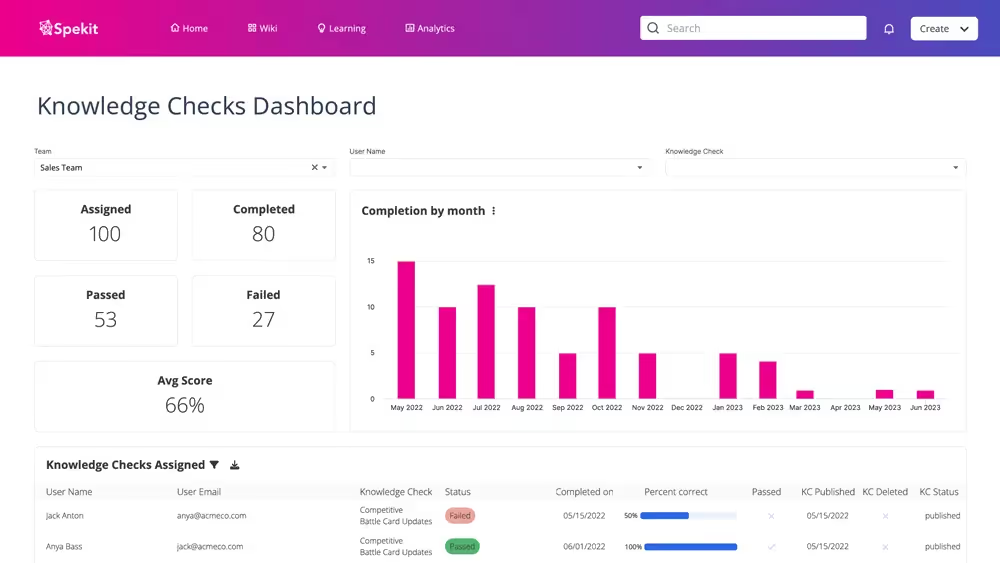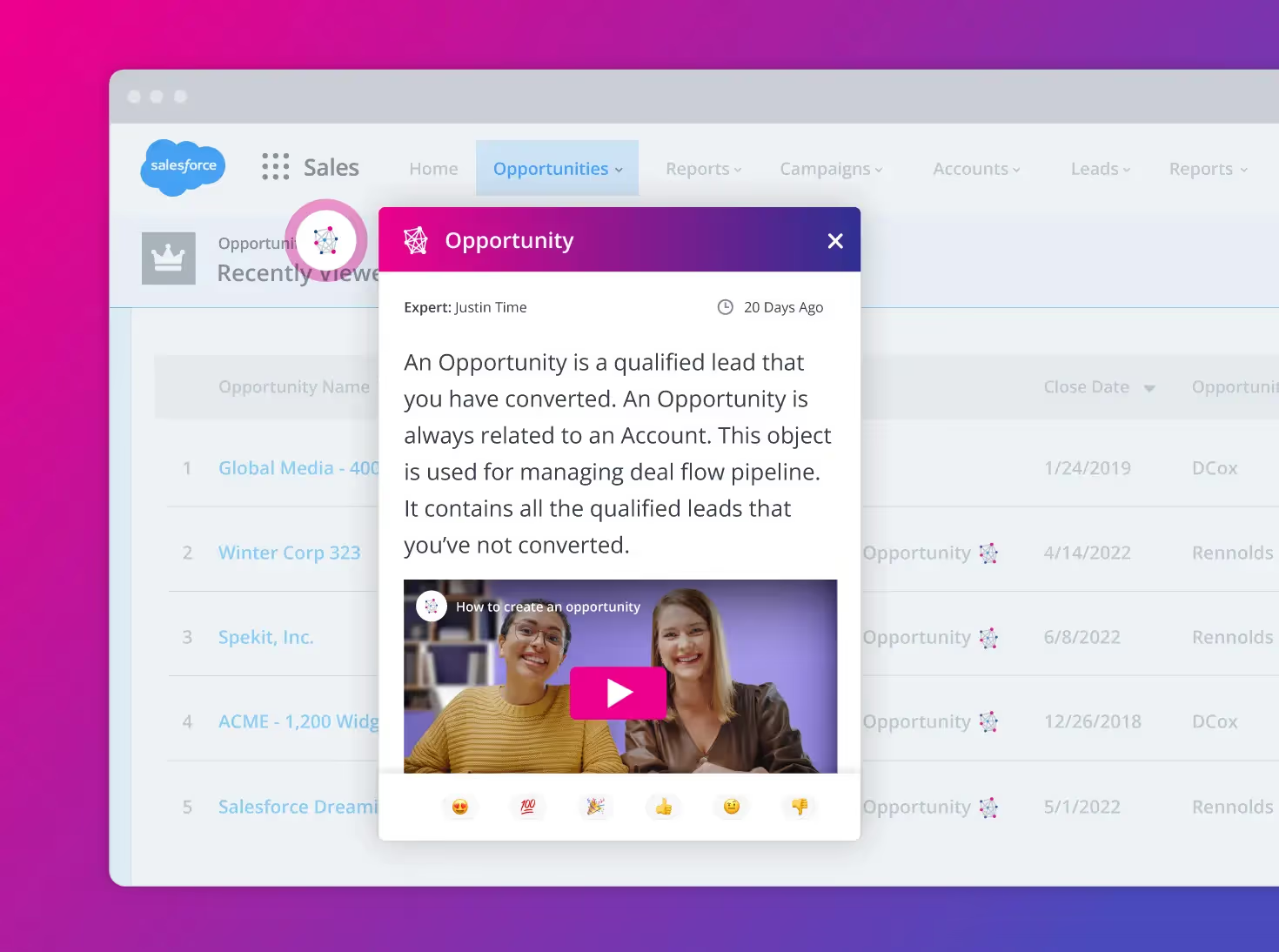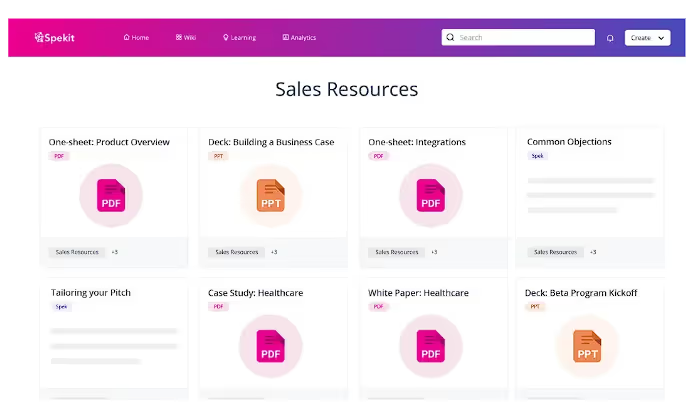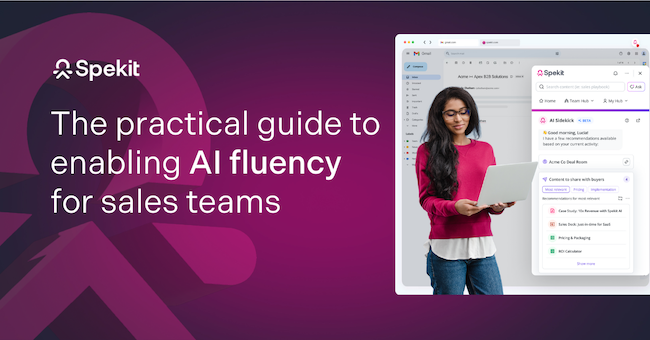A defined sales enablement strategy is the difference between a business not meeting its sales quota expectations and smashing its revenue goals. When done right, sales enablement best practices align a business's revenue objectives with growing market demands, help businesses meet sales targets, and curate personalized experiences for buyers that improve win rates and increase revenue.
Forbes research reveals that 59% of companies surpass their revenue targets, with 72% exceeding the target by 25% because they have an effective sales enablement process. The goal of sales enablement is simple: to equip your revenue teams (sales and marketing) with every resource they need to sell better.
In this article, you’ll learn the importance of sales enablement and best practices that will help you meet and exceed revenue goals.
What is Sales Enablement?
Sales enablement is a continuous process involving strategies and processes that connect revenue-facing teams to training, knowledge, resources, and sales assets they need to close more deals.
It strategically combines sales training programs, content management, enablement metrics, and sales enablement software to streamline revenue-generating processes. For example, SendLane used Spekit, a sales and revenue enablement software, to grow its sales team, generate $3.7 million in the pipeline, and close three-quarters of a million within six months.
The Importance of Sales Enablement
Here’s why you need sales enablement in your business:
Aligning Sales and Marketing Teams
Sales and marketing teams have intersecting roles. Marketing supports sales with the information they need to sell to buyers, and sales reiterates buyer feedback to marketing.
However, there’s a disconnect between sales and marketing in many organizations. Almost 60% of sales teams create sales content themselves, while 90% of content produced by marketing goes unused.
Sales enablement fosters collaboration and communication between both teams, enabling marketing to create sales materials suited for the sales pipeline and sales to use those materials effectively.
Enhancing Sales Performance
Organizations that invest in sales enablement practices like upskilling/reskilling sales teams and giving them access to a centralized platform with all the tools they need to sell see an increase in overall team performance.
Sales reps achieve quota when guided by a robust sales enablement strategy, contributing to improving sales metrics like revenue per rep and lower customer acquisition costs.
Sales Enablement Best Practices
Let’s look at sales enablement best practices to help you streamline your business and sell better:
1. Establish Clear Goals and Objectives
Before implementing sales enablement strategies, you should define your goals. Do you want to organize your clunky CMS so sales content is more accessible or do you want reps to learn skills that fit needed for a particular market? Or both?
Establishing a clear goal and objective will help you break them down into measurable KPIs and sales enablement metrics like lead response time, sales cycle length, conversion rates, deal sizes, and revenue attainment.
2. Foster Sales and Marketing Alignment
74% of high-performing businesses have aligned sales and marketing teams. When your sales and marketing teams know established goals and objectives and clearly understand their functions, it is easy to implement sales enablement and support them by automating manual or repetitive tasks, giving them more time to focus on customers.
Let’s say you’re a tech company selling point-of-sale systems to superstores. Your marketing team would create detailed technical documentation and how-to guides for customers.
The sales team delivers the content to customers, then collects frequently asked questions and notes hurdles customers face while engaging with it, and sends this to marketing. Marketing then implements feedback from customers to improve content.
Without the connection between sales and marketing, there’s no way for customer feedback to reach the business.
3. Invest in the Right Technology Stack
Sales enablement requires administrative tasks like organizing training lessons, creating sales content, measuring progress, and collecting feedback from key stakeholders. But with the right technology, you can optimize and streamline sales enablement.
With sales enablement software like Spekit, you can automate manual processes, implement AI sales enablement strategies, and focus on what’s important—generating higher revenue. Spekit can be used for:
- Sales content management: Use a next-gen sales content platform to reimagine the sales reps' experience by giving them instant access to sales content directly in the tools they work on daily
- Knowledge and enablement: Centralize and surface your sales knowledge management system, playbooks, and lessons reps need to ramp and close deals faster
- Tool and process adoption: Support sales reps with step-by-step walkthroughs to help them navigate tools and processes, driving faster adoption of your tech stack
- Employee onboarding and training: Coach reps from their fast day to their last and ramp new sales reps 50% faster with self-guided onboarding.
- Sales processes and playbooks: Surface process and playbooks reps need when they need them (i.e., while engaging a prospect) to enable them to convert prospects to leads faster
- Marketing and sales alignment: Consolidate marketing and sales content in a single platform
- Change management: Communicate, support, and guide employees through organizational changes through reinforcement learning.
- Integrations: Embed sales content, training, and processes in third-party software like Chrome, Slack, etc.
.avif)
Compared to sales enablement alternatives, Spekit is an easy-to-use platform that has helped sales teams achieve 20% higher rep quota attainment, 70% increased deal save rate, and 50% less time communicating changes.
4. Leverage Data and Analytics
With data and analytics, you let data speak for your efforts. You can set up dashboards to track important metrics like conversion rates, content usage, lead generation, revenue per rep, etc. This helps you know what part of your sales enablement strategy is effective and what’s not working so you can make changes.
With Spekit Analytics, you can identify coaching opportunities and training gaps, identify habits of top performers to replicate with your entire team, drive accountability with processes and best practices, and understand which content is most helpful to maximize your materials.

5. Encourage Sales and Customer Feedback Loops
The ultimate goal of a sales enablement strategy is to give buyers the best experience possible when they use your product. Customer feedback is the only way to know if you’ve achieved this goal. When you show customers that you care about their opinions, you’ll attract brand loyalty and more revenue per customer.
Customer feedback loops involve collecting product reviews to learn your business's perceived value and areas for improvement that customers would love. Your sales team is best equipped to handle customer feedback since they deal with c from pipeline to sales.
6. Personalize Buyer Engagements
A study by SmartHQ revealed that 72% of buyers would only engage with marketing content tailored to their specific interests. Buyers want personalized experiences and get frustrated when they don’t get it.
The average buyer already has enough information about their pain points and what product they need to solve their problem. Therefore, they need to be convinced that your product seamlessly fits their needs.
Sales enablement should support personalization beyond just putting a customer's name on a template document or email. You should thoroughly understand your customers' likes and dislikes, onboard them individually after they purchase your products, and constantly reach out to them to collect feedback.
You drive customer loyalty this way and increase the chances of your product being recommended to other people.
7. Develop Comprehensive Training Programs
Sales training can boost sales representatives' performance by up to 20%. Reps who receive training are more likely to engage customers in productive conversations and give them personalized buying experiences.
Onboarding, upskilling, and reskilling sales reps through comprehensive training programs will help them use the sales enablement resources you provide effectively.
You can use sales coaching software like Spekit to create easily digestible training lessons that fit right into your sales reps' workflows so they can learn on the job—or supplement it with sales classes that reinforce core concepts like onboarding, playbooks, and sales tech adoption.

8. Promote a Culture of Continuous Learning
Employees are more likely to adopt your sales enablement strategy when you provide them with access to continuous learning opportunities relevant to their career growth. This lowers employee turnover rates and increases win rates.
In addition, businesses that implement continuous learning report higher profits. Buyer needs and persona are ever-evolving, so your sales reps have to be, too, if you want to continue making a profit.
To ensure your sales and marketing teams are always equipped with the skills they need to engage any buyer, you must set up and promote a culture of continuous learning within your organization.
9. Optimize Sales Processes

Sales processes are the set of defined steps that a sales representative follows to turn a prospect into a customer. Creating a structured sales process and documenting it on a platform sales teams can access helps them develop a consistent approach to winning customers. It also ramps up onboarding new reps.
By optimizing sales processes, you create a formula for selling based on established goals and objectives. It’s easier to identify what enablement activities are wasting time and resources and which have the best ROI.
10. Implement a Content Management Strategy
On average, your business would have about 1400 sales assets. Without a content management strategy, you’ll never know which sales assets are outdated or when you need to create new ones.
A sales content management strategy enables you to give sales reps the content they need at every buyer journey stage. This ensures that your team has seamless access to accurate, up-to-date information whenever they need it. Rather than having sales materials spread across multiple inaccessible repositories, you can centralize everything, making it possible for reps to find information immediately. A strategy also shows content effectiveness, usage, and gaps that must be filled.
Spekit is one of the best sales content management systems that enables you to simplify your content management. Spekit simplifies managing your sales materials, making it a breeze to upload, organize, and find everything you need.
Spekit integrates seamlessly with the tools your reps already use, like Slack, Salesforce, and Outreach. They can access the latest sales materials and share them directly within their workflow, without ever switching apps.

11. Ensure Cross-Functional Collaboration
Companies tend to see sales and marketing as completely separate functions rather than as two sides of the same coin working toward the same goal. This usually creates a problem where both teams don’t understand or see the financial value of each other.
Cross-functional collaboration is a strategic play to bring sales and marketing under one function and enhance communication between both. You should encourage more face time between both teams, regular information flow, and occasionally switch roles so that everyone is aware of everything happening within the respective teams.
12. Measure and Refine Strategies Regularly
It’s okay for your sales enablement strategy not to be perfect. However, you’ll know it needs improvement by regularly checking and measuring progress against already-set benchmarks. Your sales enablement has to be flexible enough to accommodate growing customer needs, continuous learning by the sales and marketing team, and increasing sales assets.
Measuring and refining strategies regularly can help you achieve the following:
- Continuous improvement: You will always have insights into what processes are working well and make improvements to those that aren’t
- Optimization: After identifying areas of inefficiencies, you can implement a better strategy to improve performance.
- Consistent alignment with business goals: Over time, you might lose sight of how you plan to achieve your goals and objectives. Refining strategies regularly helps to stay on track.
Start Implementing your Sales Enablement Best Practices
Once you've crafted your sales enablement strategy—training, fostering collaboration, and managing content—it's time to unlock its potential. Spekit, the all-in-one sales enablement platform, streamlines everything into one centralized hub.
Spekit’s AI-powered sales enablement platform is built to help businesses build the best revenue-facing teams. Spekit offers enablement that works where sales reps work. It is the only enablement platform that centralizes and automatically surfaces resources sales representatives need in any tool or workflow.
Spekit lets you create easily digestible in-context training materials that reps can learn while working, speeding up knowledge reinforcement. With Spekit, you can unify all internal and external sales materials for reps. The platform has intuitive features like rapid AI content creation, smart trackable content, holistic analytics, and simplified file management.
Thousands of enablement teams across enterprises and startups, including Uber Freight, Addigy, SendLane, Road Scholar, Zoom, and Copado, trust Spekit. Join them today and take your sales enablement strategy to the next level.







